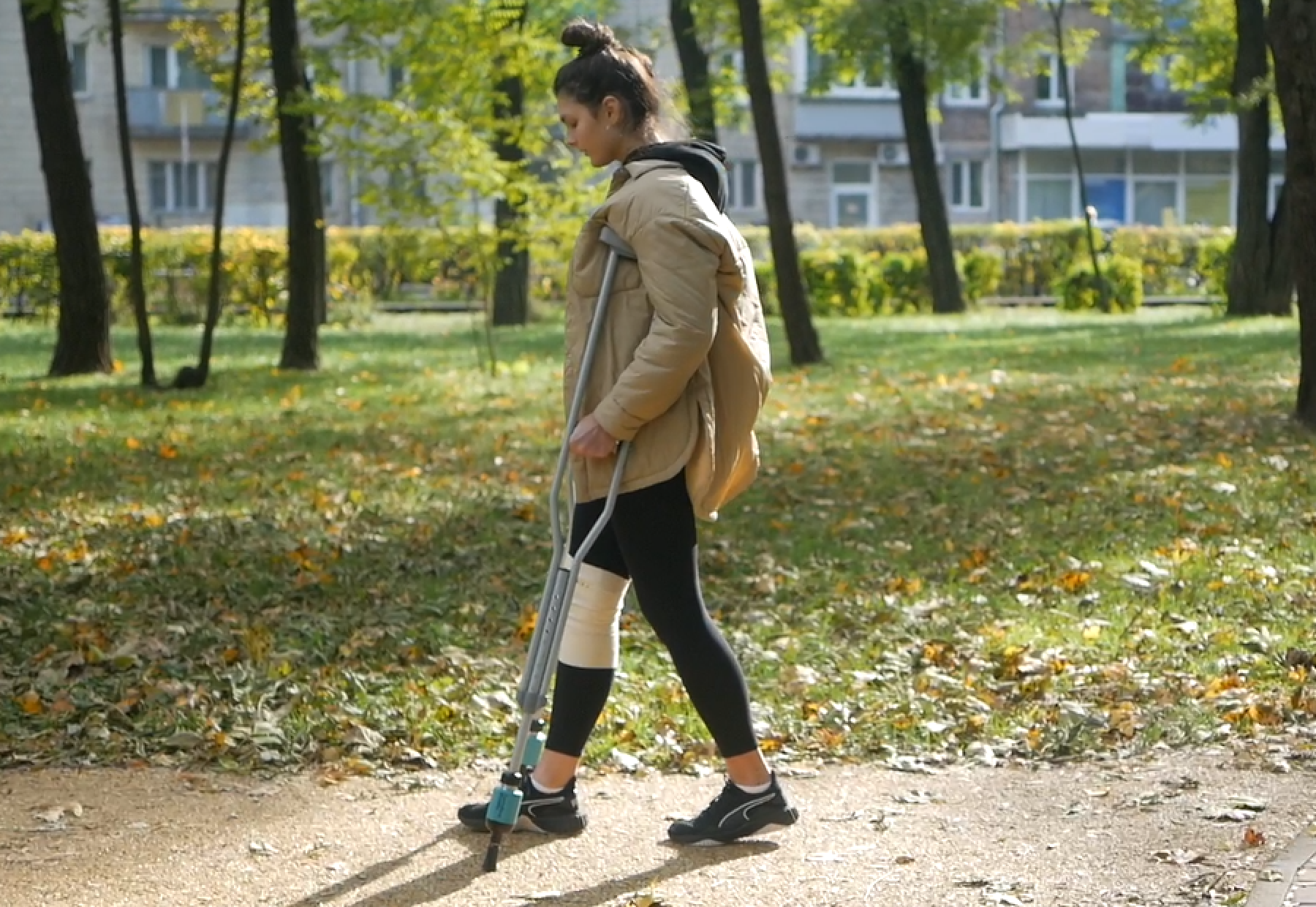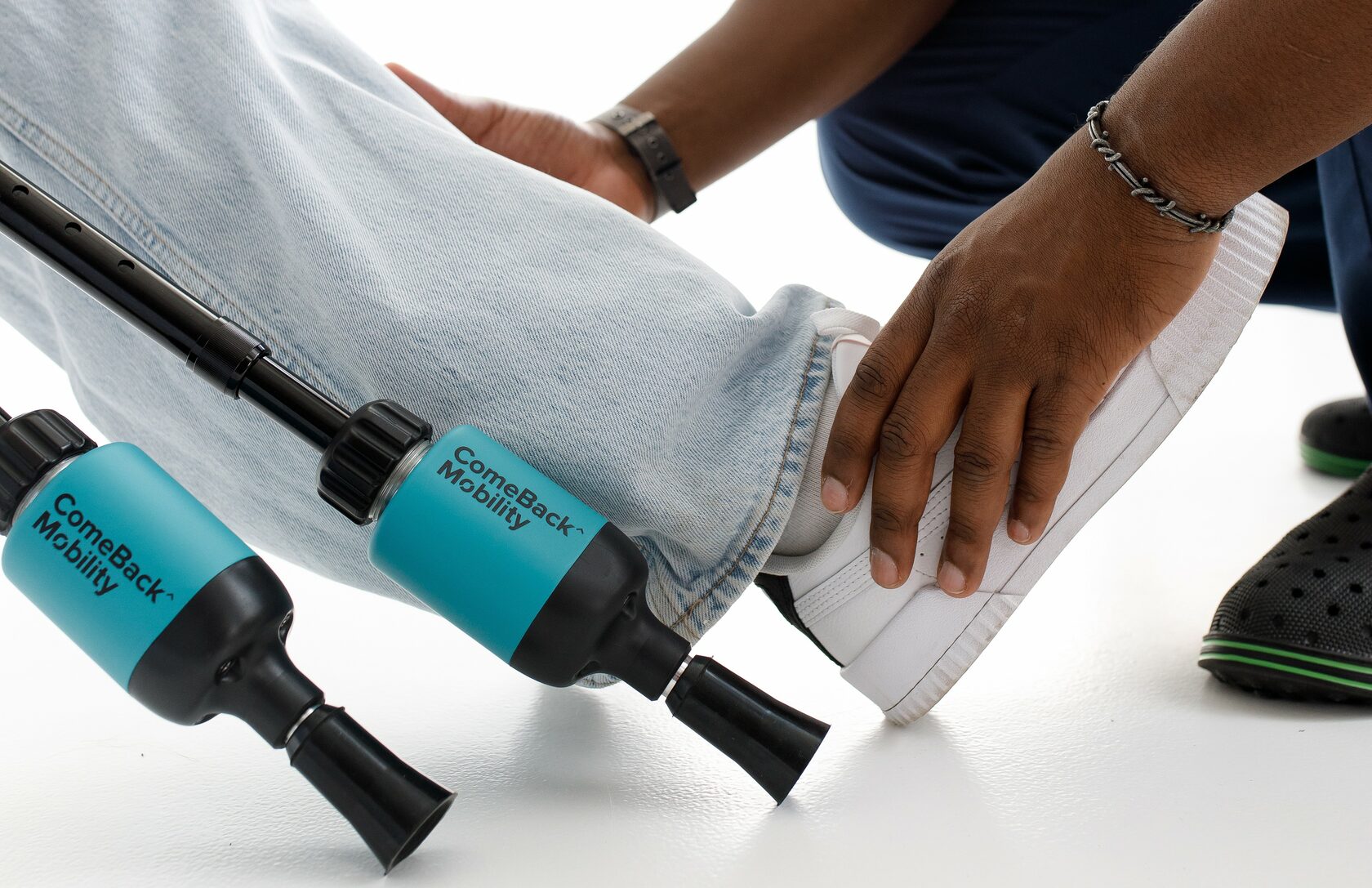Crutches are often required for successful rehabilitation after an injury or surgery to the lower extremity. Walking with crutches helps protect the involved leg, improves balance, and ensures a steady posture while walking. Crutches increase a person’s independence and self-efficacy during a time of loss of mobility. It is important to learn how to use crutches properly to realize these benefits.
How do I know how much weight I can put on my leg?
After your injury evaluation, or after a surgery, your orthopedist will tell you how much weight you are allowed to place on your leg while you are healing. This is your prescribed weight-bearing (WB) status. To avoid complications, you should strictly adhere to the weight-bearing instructions. The medical staff and rehabilitation team will fit you with your crutches, help you understand the prescribed WB status, and teach you how to keep to it.

After your injury evaluation, or after a surgery, your orthopedist will tell you how much weight you are allowed to place on your leg while you are healing. This is your prescribed weight-bearing (WB) status. To avoid complications, you should strictly adhere to the weight-bearing instructions. The medical staff and rehabilitation team will fit you with your crutches, help you understand the prescribed WB status, and teach you how to keep to it.

Book design is the art of incorporating the content, style, format, design, and sequence of the various components of a book into a coherent whole. In the words of Jan Tschichold, “methods and rules upon which it is impossible to improve, have been developed over centuries. To produce perfect books, these rules have to be brought back to life and applied.”
Front matter, or preliminaries, is the first section of a book and is usually the smallest section in terms of the number of pages. Each page is counted, but no folio or page number is expressed or printed, on either display pages or blank pages.
Weight-Bearing (WB) Restrictions





Weight-bearing restrictions are prescribed by the orthopedist to optimize the healing process for the involved leg. Typically, the progression of weight-bearing proceeds from least amount of load on the leg to incrementally matching the uninvolved leg. If the prescribed WB status is not adhered to, the surgical procedures and healing can be compromised leading to complications. This can lead to a reversal of the weight-bearing status to a lower load and a longer recovery. The goal is to always be moving forward in your rehabilitation without complications.
Whether you are preparing for a surgery, or just came home from the Doctor’s office and need a reminder of what the WB restrictions mean, here is a list explaining the various WB statuses you may encounter during your rehabilitation.
The list reads from most restrictive to least restrictive.
Non weight-bearing (NWB)





In the beginning, you may be told to completely avoid weight-bearing on the injured leg, this is NWB. It is the most restrictive weight-bearing status as no weight is placed on the involved leg. The injured leg never takes a step, and the crutches and your healthy leg accept the full weight of the body.
Once a non-weight-bearing phase is over, your doctor will consult you on using a toe-touch weight-bearing approach.
Toe-touch weight-bearing (TTWB)





I In TTWB, you can place your foot on the ground for balance during crutch walking. Depending on your post-surgical bracing, or available range of motion in the hip, knee, or ankle, you can either step on the toe, or place the whole foot on the ground without load. Here you are beginning to use a natural walking stride and motion, but without any load. A common analogy is that you have an egg under your foot that you do not want to crush.
Helpful Tip: Throughout the crutch walking prescription progression, ask your orthopedist questions regarding their definition and expectation of each WB status. There are subtle variations among physicians for their acceptable load at TTWB and PWB. By asking questions, this ensures everyone has the same information and understanding of the rehabilitation plan.
Partial weight-bearing (PWB)





In PWB, the doctor prescribes a specific load percentage (between 30% to 50% of body weight) for a particular length of time. Now you can begin placing a prescribed weight through the involved leg during crutch walking. During PWB, your body accommodates or gets used to the new prescribed load. At physician appointments, a reevaluation checks for rehabilitation milestones before increasing the WB load allowance. This systematic progression of WB helps optimize the recovery process. PWB is a challenging and critical phase of rehabilitation to ensure proper weight distribution without overloading an injured leg. Your WB compliance is very important to the success of the surgery or recovery from an injury.
Helpful Tip: Smart Crutch Tips are an excellent tool for improving your WB compliance throughout the crutch walking gait rehabilitation process. Their auditory, visual, and vibration feedback features help guide you to proper weight-bearing on your involved leg. This keeps you moving forward one step at a time, decreasing risks of complications and any delays in your recovery.
Weight-bearing as tolerated (WBAT)





WBAT is a progressive loading onto the involved leg using your own tolerance to guide the weight-bearing process. Your injury and surgery dictate the starting load percentage. Typically, you begin at 25% of your body weight and then see how your leg reacts to the new stresses. You and your PT will pay attention not only to pain, which is a subjective experience, but also to objective changes in swelling, range of motion, and muscle activity.
Before increasing the WB load, the goal is for your pain levels to be low to zero, swelling low to zero, and maintaining your gains in range of motion, muscle activity, and activities of daily living. Just as in PWB, the systematic progression of WB helps optimize the recovery process and decreases the risk of overloading the leg.
Once you can walk at 75-80% of body weight, often patients transition to one crutch or a cane. At each step in the process, your physical gains are improving the quality of your walking. At the end of the crutch and cane walking process, the goal is to walk fluidly without a limp.

Once you can walk at 75-80% of body weight, often patients transition to one crutch or a cane. At each step in the process, your physical gains are improving the quality of your walking. At the end of the crutch and cane walking process, the goal is to walk fluidly without a limp.

SOURCES
- Patient compliance with touchdown weight bearing after microfracture treatment of talar osteochondral lesions
- Patient compliance with postoperative lower extremity touch-down weight-bearing orders at a level I academic trauma center
- (PDF) Weight Bearing Compliance after Foot and Ankle Surgery
- Factors Affecting Compliance With Weight-Bearing Restriction and the Amount of Weight-Bearing in the Elderly With Femur or Pelvic Fractures
- Application Of Calculating The Maximum Permissible Load On The Femur After Osteosynthesis
- Current advances in training orthopaedic patients to comply with PWB instructions
- Force Plates – Do you need one?
- Different in-shoe devices for partial weight bearing
- Effectiveness of a Simple Auditory Feedback Insole






